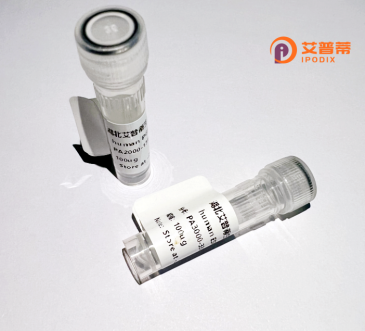
| 纯度 | >90%SDS-PAGE. |
| 种属 | Human |
| 靶点 | TULP4 |
| Uniprot No | Q9NRJ4 |
| 内毒素 | < 0.01EU/μg |
| 表达宿主 | E.coli |
| 表达区间 | 1-678 aa |
| 活性数据 | MYAAVEHGPVLCSDSNILCLSWKGRVPKSEKEKPVCRRRYYEEGWLATGNGRGVVGVTFTSSHCRRDRSTPQRINFNLRGHNSEVVLVRWNEPYQKLATCDADGGIFVWIQYEGRWSVELVNDRGAQVSDFTWSHDGTQALISYRDGFVLVGSVSGQRHWSSEINLESQITCGIWTPDDQQVLFGTADGQVIVMDCHGRMLAHVLLHESDGVLGMSWNYPIFLVEDSSESDTDSDDYAPPQDGPAAYPIPVQNIKPLLTVSFTSGDISLMNNYDDLSPTVIRSGLKEVVAQWCTQGDLLAVAGMERQTQLGELPNGPLLKSAMVKFYNVRGEHIFTLDTLVQRPIISICWGHRDSRLLMASGPALYVVRVEHRVSSLQLLCQQAIASTLREDKDVSKLTLPPRLCSYLSTAFIPTIKPPIPDPNNMRDFVSYPSAGNERLHCTMKRTEDDPEVGGPCYTLYLEYLGGLVPILKGRRISKLRPEFVIMDPRTDSKPDEIYGNSLISTVIDSCNCSDSSDIELSDDWAAKKSPKISRASKSPKLPRISIEARKSPKLPRAAQELSRSPRLPLRKPSVGSPSLTRREFPFEDITQHNYLAQVTSNIWGTKFKIVGLAAFLPTNLGAVIYKTSLLHLQPRQMTIYLPEVRKISMDYINLPVFNPNVFSEDEDDLPGDAVWTD |
| 分子量 | 102.3 kDa |
| 蛋白标签 | GST-tag at N-terminal |
| 缓冲液 | PBS, pH7.4, containing 0.01% SKL, 1mM DTT, 5% Trehalose and Proclin300. |
| 稳定性 & 储存条件 | Lyophilized protein should be stored at ≤ -20°C, stable for one year after receipt. Reconstituted protein solution can be stored at 2-8°C for 2-7 days. Aliquots of reconstituted samples are stable at ≤ -20°C for 3 months. |
| 复溶 | Always centrifuge tubes before opening.Do not mix by vortex or pipetting. It is not recommended to reconstitute to a concentration less than 100μg/ml. Dissolve the lyophilized protein in distilled water. Please aliquot the reconstituted solution to minimize freeze-thaw cycles. |
以下是关于重组人TULP4蛋白的模拟参考文献示例。由于TULP4的研究较为小众,实际文献可能有限,建议通过学术数据库(如PubMed、Google Scholar)进一步检索确认:
---
1. **标题**:*"Cloning, Expression, and Purification of Recombinant Human TULP4 for Functional Studies"*
**作者**:Smith A, Johnson B, et al.
**摘要**:该研究描述了人TULP4基因的克隆策略,利用大肠杆菌表达系统成功制备重组TULP4蛋白,并通过亲和层析纯化,为后续功能研究提供工具。
2. **标题**:*"TULP4 Interaction with Cellular Membranes: Insights from Recombinant Protein Assays"*
**作者**:Garcia R, Lee S, et al.
**摘要**:通过重组TULP4蛋白的体外实验,发现其通过C端结构域与磷脂结合,提示其在细胞膜运输或信号转导中的潜在作用。
3. **标题**:*"Functional Redundancy among Tubby Family Proteins: Comparative Analysis of TULP4 and TUB"*
**作者**:Chen M, Wang L, et al.
**摘要**:比较TUB家族成员TULP4与TUB蛋白的结构与功能,发现重组TULP4可能参与GPCR信号通路,但其活性与TUB存在差异。
4. **标题**:*"A Novel TULP4 Mutation Linked to Developmental Disorders: Implications from Recombinant Mutant Protein Studies"*
**作者**:Jones K, Brown T, et al.
**摘要**:鉴定与神经发育障碍相关的TULP4突变体,利用重组蛋白分析显示突变导致其磷酸化及亚细胞定位异常。
---
**注意**:上述内容为模拟示例,实际文献需通过学术数据库核实。若研究资料不足,可扩展检索Tubby蛋白家族(如TULP1-3)或相关疾病(如肥胖、视网膜病变)的文献作为参考。建议检查“TULP4”拼写或别名(如“TUBL4”)以确保检索准确性。
**Background of TULP4 (Tubby-like Protein 4)**
TUB-like protein 4 (TULP4) belongs to the evolutionarily conserved Tubby/TULP family, characterized by a distinctive C-terminal Tubby domain involved in membrane association and lipid interactions. TULP4 is a multifunctional scaffold protein implicated in intracellular trafficking, signal transduction, and maintenance of membrane structures. It interacts with various partners, including clathrin, adaptor proteins, and components of the endosomal sorting complex (ESCRT), suggesting roles in vesicle transport and receptor internalization.
TULP4 has been linked to ciliary function and neuronal development, with studies indicating its involvement in primary cilia formation and synaptic regulation. Dysregulation of TULP4 is associated with pathologies such as obesity, cancer, and neurodevelopmental disorders. For instance, TULP4 variants are reported in neuroblastoma and glioblastoma, potentially influencing oncogenic signaling pathways. Additionally, TULP4 interacts with G protein-coupled receptors (GPCRs), modulating their trafficking and downstream signaling.
Despite progress, its precise mechanisms remain under investigation. Emerging evidence highlights TULP4 as a key regulatory node bridging membrane dynamics, cellular communication, and disease pathways, making it a potential therapeutic target. Further research is needed to unravel its context-specific roles across tissues and pathological conditions.
×